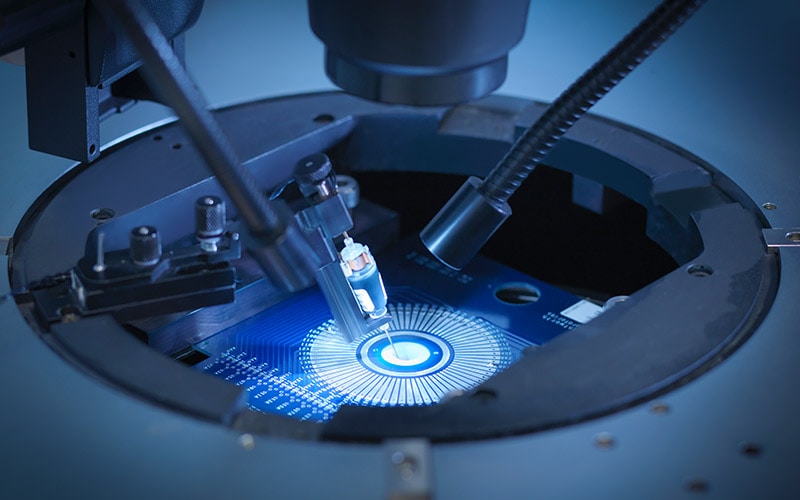Insights
- AI-powered semiconductor manufacturing equipment is enabling fabs to achieve higher precision, greater efficiency, and improved yield.
- Adaptive calibration using AI enhances precision and efficiency in semiconductor equipment.
- Generative AI aids in advanced machine diagnosis, reducing downtime and improving maintenance efficiency.
- AI-powered imaging systems improve defect detection and reduce waste in semiconductor manufacturing.
Introduction
From smartphones and laptops to medical devices and automotive systems, semiconductors are the building blocks of modern technology. The semiconductor equipment sector is a fundamental pillar of the semiconductor industry, providing the machinery and tools required to produce semiconductor chips.
The semiconductor equipment industry is predicted to grow from $109.4 billion in 2024 to $155 billion in 2029 at a compounded annual growth rate (CAGR) of 7.3%. As demand for semiconductors continues to surge, driven by advancements in agentic AI and generative AI, the internet of things (IoT), 5G, and electric vehicles, the complexity and demand for semiconductor manufacturing equipment are also set to rise. Producing integrated circuits on silicon wafers requires specialized tools, including photolithography machines for patterning, etching systems for shaping circuits, deposition equipment for layering materials, ion implanters for doping, and inspection and metrology systems to ensure precision and quality.
Rapid innovation and short product life cycles require the semiconductor industry to continuously adapt its manufacturing processes and tools. The need for advanced nodes (2nm, 3nm) and more energy-efficient chips pushes the boundaries of current manufacturing capabilities, necessitating continuous innovation in equipment design and functionality. However, semiconductor manufacturing faces many challenges in meeting the demand. Traditional defect detection methods generate high false positives, leading to excessive manual inspections and increased wafer waste, which slow down production and raise costs. Calibration and measurement processes are often slow and inconsistent, struggling to adapt to real-time variations, resulting in misalignments and yield losses. Furthermore, legacy systems are ill-equipped to manage and analyze the vast, complex data generated during production, limiting predictive maintenance and process optimization. Repair processes can be inefficient and time-consuming due to the complexity of equipment and reliance on manual troubleshooting. AI-powered smart fabrication facilities (fabs) are transforming semiconductor manufacturing by addressing these issues.
How to make fabs smarter
AI-powered equipment will help fabs address rising cost pressures, accelerate production speed, and maintain high precision. From predictive maintenance and real-time defect detection to adaptive calibration, AI can enhance equipment efficiency, reduce downtime, and shorten production cycles.
To adopt AI-powered fabrication equipment, semiconductor enterprises must re-evaluate their overall equipment management strategies, particularly around data integration, maintenance planning, and process control. Figure 1 illustrates the key components of a smart fab, while this article highlights how AI and machine learning (ML) are driving transformation in cost reduction, operational efficiency, and productivity.
Figure 1. Smart fab: Core systems and equipment
Source: Infosys Knowledge Institute
High-precision imaging and analysis
AI-powered equipment uses advanced imaging techniques and ML algorithms to detect and classify defects in real time. These models can differentiate between true defects and noise, reducing false positives and and improving defect detection accuracy. For example, Applied Materials’ SEMVision H20 integrates deep-learning models with advanced imaging to deliver analysis up to three times faster than previous techniques, enabling chipmakers to maintain inspection quality while accelerating production.
- Wafer inspection: AI-powered imaging systems can inspect wafers for defects at various stages of the manufacturing process. ML algorithms analyze high-resolution images to detect surface defects, such as scratches, particles, and pattern deviations. This ensures that only defect-free wafers proceed to the next stage, improving yield and reducing waste.
- Critical dimension measurement: AI can improve the measurement of critical dimensions in semiconductor manufacturing. By analyzing images from scanning electron microscopes, AI algorithms can accurately measure the width of lines and spaces on a wafer. This ensures that the dimensions meet the required specifications.
- Overlay metrology: Overlay metrology involves measuring the alignment accuracy between different layers of a semiconductor device. AI algorithms can analyze imaging data to detect misalignments and provide real-time feedback for corrective actions. This ensures that each layer is perfectly aligned, which is critical for the performance and reliability of the semiconductor.
- Automated optical inspection: AI-driven automated optical inspection (AOI) systems can automatically inspect semiconductor wafers and components for defects. These systems use machine learning algorithms to analyze optical images and detect defects with high accuracy. This reduces the need for manual inspections and increases the throughput of the inspection process. For example, a recent study claims that AI powered AOI systems achieve accuracy between 97% and 99% in defect classification, compared to typical legacy AOI tools which are in the range of between 85% and 90%. And, false positives drop to under 10%.
Smart calibration to combat variations
Adaptive calibration in semiconductor manufacturing leverages AI and ML to dynamically optimize the calibration process based on real-time data and historical performance. By continuously analyzing sensor data, AI systems can make real-time adjustments to maintain optimal operating conditions, ensuring high precision and efficiency.
For example, if a sensor detects a deviation from the optimal operating conditions, the AI system can automatically adjust the relevant parameters to bring the equipment back within the desired range. This ensures that the equipment operates at peak efficiency and maintains high precision.
Predictive models forecast the best calibration settings, while a feedback loop refines these models over time. This tailored approach reduces calibration time, extends equipment lifespan, and enhances overall reliability, making the calibration process more accurate and efficient.
Advanced machine diagnosis using generative AI
Generative AI can enhance the repair and troubleshooting of equipment by providing advanced diagnostic capabilities and real-time solutions. It can generate detailed troubleshooting guides and repair instructions tailored to specific issues, reducing downtime and improving the efficiency of maintenance operations.
Future outlook
AI adoption in the semiconductor equipment industry faces many of the same challenges seen across other sectors, including limited access to high-quality, standardized data, integration with legacy systems, and concerns around model reliability and explainability. However, these challenges are amplified in semiconductor manufacturing due to the precision, scale, and sensitivity of the processes involved. Many equipment manufacturers and fabs also face shortages of specialized talent needed to develop, deploy, and maintain AI systems in high-throughput production environments. Additionally, increased connectivity and data sharing raise cybersecurity and intellectual property protection risks, especially when proprietary process and tool data flow across systems and vendors.
Addressing these challenges through ecosystem-wide collaboration, investment in infrastructure and skills, and the development of trustworthy, interoperable AI solutions is critical.
To successfully adopt AI-powered semiconductor equipment, it’s important to clearly define use cases, whether it’s defect detection, predictive maintenance, or process optimization.
Invest in high-quality, centralized data infrastructure, as AI performance depends on clean, well-labeled data from equipment logs, images, and process parameters. Begin with small pilot projects to demonstrate value and gain internal support before scaling.
Most importantly, foster collaboration between semiconductor engineers and data scientists to bridge the gap between domain expertise and AI modeling. This ensures accurate data labeling, realistic expectations, and effective implementation of AI solutions tailored to complex semiconductor manufacturing environments.
By breaking down data silos and fostering partnerships between original equipment manufacturers, fabs, and technology providers, the industry can unlock the full potential of AI. This will prove especially worthwhile given the extreme precision required in semiconductor manufacturing, where even nanometer-scale deviations can impact yield, performance, and reliability. Leveraging AI effectively will enable fabs to meet the demands of advanced nodes, accelerate innovation cycles, and maintain competitiveness in an increasingly complex global market.




